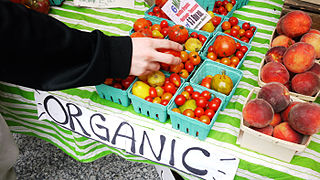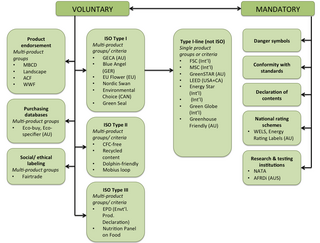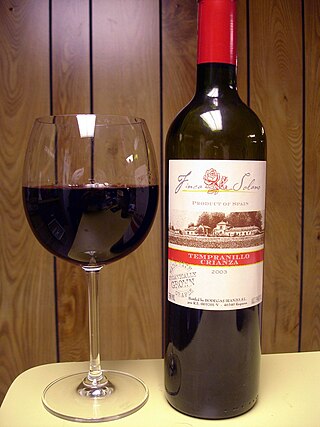Vegan organicagriculture is the organic production of food and other crops with minimal animal inputs. Vegan organic agriculture is the organic form of animal-free agriculture.

The organic movement broadly refers to the organizations and individuals involved worldwide in the promotion of organic food and other organic products. It started during the first half of the 20th century, when modern large-scale agricultural practices began to appear.

Organic certification is a certification process for producers of organic food and other organic agricultural products, in the European Union more commonly known as ecological or biological products. In general, any business directly involved in food production can be certified, including seed suppliers, farmers, food processors, retailers and restaurants. A lesser known counterpart is certification for organic textiles that includes certification of textile products made from organically grown fibres.

Ecolabels and Green Stickers are labeling systems for food and consumer products. The use of ecolabels is voluntary, whereas green stickers are mandated by law; for example, in North America major appliances and automobiles use Energy Star. They are a form of sustainability measurement directed at consumers, intended to make it easy to take environmental concerns into account when shopping. Some labels quantify pollution or energy consumption by way of index scores or units of measurement, while others assert compliance with a set of practices or minimum requirements for sustainability or reduction of harm to the environment. Many ecolabels are focused on minimising the negative ecological impacts of primary production or resource extraction in a given sector or commodity through a set of good practices that are captured in a sustainability standard. Through a verification process, usually referred to as "certification", a farm, forest, fishery, or mine can show that it complies with a standard and earn the right to sell its products as certified through the supply chain, often resulting in a consumer-facing ecolabel.

The Rainforest Alliance is an international non-governmental organization (NGO) with staff in more than 20 countries and operations in more than 70 countries. It was founded in 1987 by Daniel Katz, an American environmental activist, who serves as the chair of the board of directors. The NGO states that its mission is "to create a more sustainable world by using social and market forces to protect nature and improve the lives of farmers and forest communities." Its work includes the provision of an environmental certification for sustainability in agriculture. In parallel to its certification program, the Rainforest Alliance develops and implements long-term conservation and community development programs in a number of critically important tropical landscapes where commodity production threatens ecosystem health and the well-being of rural communities.
An organic product is made from materials produced by organic agriculture. Most well known organic products are organic food items, however clothing and personal care items can also be made with organic agriculture.

Cradle-to-cradle design is a biomimetic approach to the design of products and systems that models human industry on nature's processes, where materials are viewed as nutrients circulating in healthy, safe metabolisms. The term itself is a play on the popular corporate phrase "cradle to grave", implying that the C2C model is sustainable and considerate of life and future generations—from the birth, or "cradle", of one generation to the next generation, versus from birth to death, or "grave", within the same generation.

The China Green Food Development Center is the first agency in the People's Republic of China to oversee organic food standards. The Center was established in November 1992 under the jurisdiction of the Ministry of Agriculture of the People's Republic of China. The CGFDC joined the International Federation of Organic Agriculture Movements(IFOAM)in 1993. It is headquartered in Beijing, where its general office and divisions of logo management, authentication, sci-tech and standards, planning and finance, and international cooperation are located. Currently, the CGFDC has set up 42 local food regulatory agencies, commissioned 38 quality inspection agencies, and 71 green food producing environmental monitoring branches. Its basic purpose is to promote the development of food that prioritizes safety, to protect the environment, and to maintain the development of economy and society. Its main responsibilities include: developing Green Food generation policies; regulating organizations that develop green food standards; organizing and guiding the development and management of Green Food; trademark green logo management; review and approval of green flag products; and organizing research, technology promotion, training, advocacy, information services, green building demonstration bases, and foreign economic and technological exchanges and cooperation. The CGFDC's main partners consist of China Organic Food Certification Center, State Food and Nutrition Consultant Committee, Food and Agricultural Organization of the United Nations and Development Research Center of the State Council as well as some media networks as supporters. It has published reports including the " Green Food Products Bulletin","Green Fashion", and "Brief Report of the Center."

Organic wine is wine made from grapes grown in accordance with the principles of organic farming, which excludes the use of artificial chemical fertilizers, pesticides, fungicides, and herbicides.

Sustainable fashion is a term describing efforts within the fashion industry to reduce its environmental impacts, protect workers producing garments, and uphold animal welfare. Sustainability in fashion encompasses a wide range of factors, including "cutting CO2 emissions, addressing overproduction, reducing pollution and waste, supporting biodiversity, and ensuring that garment workers are paid a fair wage and have safe working conditions".

Asthma & Allergy Friendly is a registered certification mark operated by Allergy Standards Limited in association with not-for-profit asthma and/or allergy organizations. They specialise in labelling products which have been put through and have passed standardised testing. The Asthma & Allergy Friendly Certification Program was created to scientifically test and identify consumer products that are more suitable for people with asthma and allergies.

The Hohenstein Laboratories is an international research and testing company founded in 1946. Around 1,000 employees work at the headquarters in Bönnigheim, Germany, as well as in 44 other countries.
Organic aquaculture is a holistic method for farming fish and other marine species in line with organic principles. The ideals of this practice established sustainable marine environments with consideration for naturally occurring ecosystems, use of pesticides, and the treatment of aquatic life. Managing aquaculture organically has become more popular since consumers are concerned about the harmful impacts of aquaculture on themselves and the environment.
Sustainability standards and certifications are voluntary guidelines used by producers, manufacturers, traders, retailers, and service providers to demonstrate their commitment to good environmental, social, ethical, and food safety practices. There are over 400 such standards across the world.
Sustainable products are products who are either sustainability sourced, manufactured or processed that provide environmental, social and economic benefits while protecting public health and environment over their whole life cycle, from the extraction of raw materials until the final disposal.

Sustainable furniture design and sustainable interior design is the design of a habitable interior using furniture, finishes, and equipment while addressing the environmental impact of products and building materials used. By considering the life-cycle impact of each step, from raw material through the manufacturing process and through the product's end of life, sustainable choices can be made. Design considerations can include using recycled materials in the manufacturing process, reutilizing found furniture and using products that can be disassembled and recycled or reclaimed after their useful life. Another method of approach is working with local materials and vendors as a source for raw materials or products. Sustainable furniture design strives to create a closed-loop cycle in which materials and products are perpetually recycled so as to avoid disposal in landfills.
Testex, stylized as TESTEX, is a globally operating, independent Swiss testing and certification organisation that focuses on textile testing. The Testex corporate group is headquartered in Zurich and consists of the Testex AG, ÖTI GmbH (Austria), PT Testex (Indonesia), Swiss Textile-Testing Ltd. Hong Kong, and Testex Testing Co. Ltd. Beijing.
Globalization of supply chains and pressure to lower production costs have negatively impacted environments and communities around the world, especially in developing nations where production of high demand goods is increasingly taking place. Since the 1990s, awareness of these negative impacts has grown, leading stakeholders to push companies to take responsibility and actively work to improve the sustainability of their supply chains. It has come to be understood that a company is only as sustainable as the start of its supply chain, bringing about the need for sustainable sourcing. Sustainable sourcing refers to the inclusion of social, environmental, and economic criteria in the sourcing process.
A Certified Organic Sunscreen, also known as Petrochemical-Free Sunscreen, is a third party certified sunscreen product consisting of certified and approved organic ingredients, with typically zinc oxide acting as the photo-protector. An organic sunscreen is verified and approved by a certifier to international or national organic standards, such as NSF/ANSI 305 and USDA organic, which define production and labelling requirements for personal care products containing organic ingredients. These standards are complemented by existing sunscreen regulatory bodies such as the FDA that regulate the efficacy of the sunscreen, safety and permitted ingredients. Generally speaking, sunscreen has photo-protective properties that reduce the risk of skin cancer and ageing with relation to the SPF value and proper application.
Plant-based leather, also known as vegan leather or eco-leather, is a type of material made from plant-based sources as an alternative to traditional leather, which is typically made from animal hides. Plant-based leather can be made from a variety of sources, including pineapple leaves, mushrooms, corn, apple peels, and recycled plastic. The growing interest in sustainable and environmentally friendly products has led to increased demand for plant-based leather in recent years.











